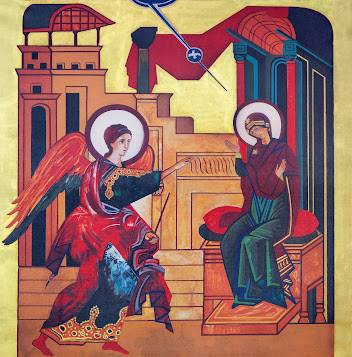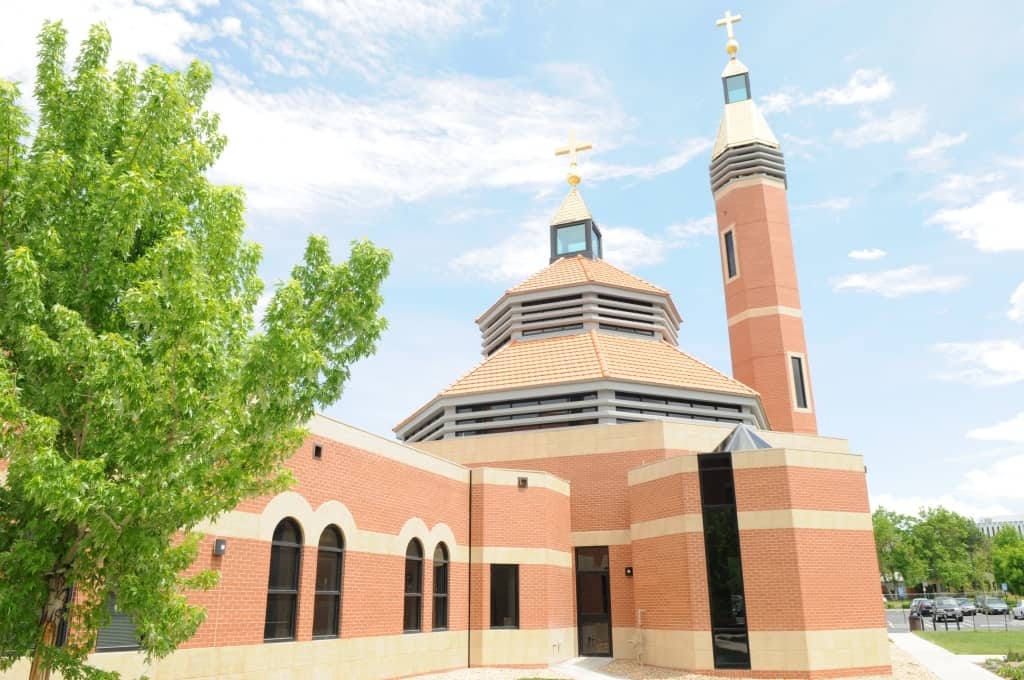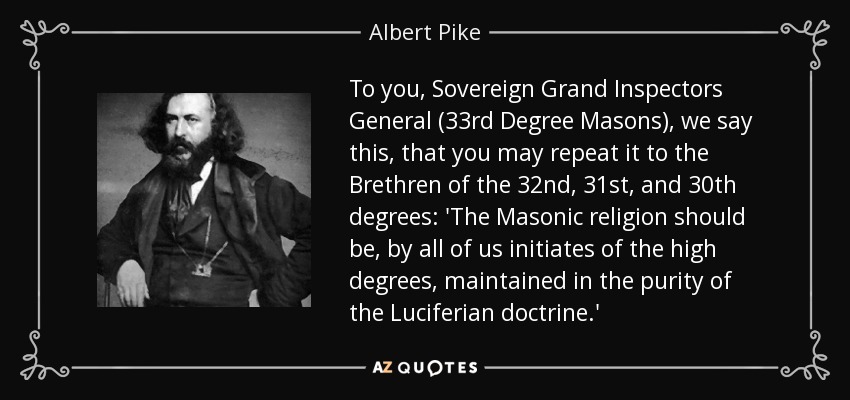The following letter comes to us from our friends at the Osservatorio, via Crux Sancta. It was written by
Giuseppe Gennarini, Kiko's American
caporegime, concerning the then-upcoming 1993 World Youth Day to be held in this blog's fair home city of Denver. It is a very interesting letter for a number of reasons, which we will address in due course.
Though undated, we approximate the letter's composition to have been sometime between
August 1991 and April 1992 (the Osservatorio posits it could have been written as early as 1990, though this seems unlikely). Gennarini references--seemingly in the past tense--the World Youth Day in Częstochowa, Poland, which took place from
August 10-15, 1991 ("Until now, all the World Youth Days have been centered..."). John Paul II made his official announcement regarding traveling to Denver on April 12, 1992, during his Palm Sunday
Angelus address (this is supported by American news articles, such as
this one from the
St. Petersburg Times, that appeared the following day). Since Gennarini seems to be operating on a rumor ("As far as I know...the chosen location is Denver), and the entire tone of the letter is to persuade against this choice, the official announcement almost certainly had not yet been made.
The letter is addressed to a certain "Father Stanisław." The hypothesis of the Osservatorio, which we fully support, is that this is Stanisław Ryłko, a Polish priest and friend of Pope John Paul II (who ordained him a priest, and also later a bishop). Between 1987 and 1992, Fr. Ryłko worked as the head of the youth office in the Pontifical Council for the Laity, and as such was responsible for coordinating three World Youth Days--Santiago de Compostela in 1989, Częstochowa in 1991, and Denver in 1993.
As already noted, Gennarini is writing to Fr. Ryłko regarding unspecified rumors regarding the destination of the upcoming 1993 World Youth Day. In order to obtain such rumors, Gennarini (and the upper echelon of the Way more broadly) must have had informants in the Curia, as such debates were not common knowledge among the wider church, especially the laity. Even 30 years ago, the Way's influential Vatican lobby was substantial.
More to the point is the incredible arrogance with which Gennarini, a layman, addresses a priest and member of the Roman Curia, simply by virtue of the power he possesses within the movement to which he belongs. Why should he dare to "suggest" that the venue for World Youth Day be changed?
I would like to point out some difficulties with the choice of city which, in my opinion, would distort the meaning of this day, especially compared to those celebrated up to now.
At the end of the 1980s, the Way was still a tiny movement, representing some 0.05% of Catholics; widespread in Italy, Spain, and Latin America, but practically absent everywhere else. The Way, however, counts on some powerful supports, and those are worth more than numbers. At the end of the 60s, they were supported by Pedro Farnés (a modernist Spanish priest and liturgist) and Casimiro Morcillo (Archbishop of Madrid from 1964 until his death in 1971), who introduced them to the right friends: Cardinal Angelo Dell'Acqua (the long-time Sosituto in the Secretariat of State and, from 1968 until his death in 1972, Vicar General of Rome) and the powerful (and controversial) Annibale Bugnini.
Throughout the 70s, they consolidated their ascent, conquering Rome's upper-class parishes and making new powerful friends, including Cardinal Ugo Poletti (Dell'Acqua's successor as Vicar General), who allowed them to build the first Redemptoris Mater seminary in 1988, which was soon followed by all the others.
This tiny movement is already very powerful in the early 90s: it has friendships in the circles that count in the Roman Curia, and only for this reason does the layman Gennarini allow himself to "have a go" at Fr. Ryłko about World Youth Day. This is also why Gennarini, with incredible presumption, believes he understands the meaning of WYD better than John Paul II, who conceived it with the intention of bringing young people closer to the faith.
Denver has no shrine or significance for the history of the American church. Its only advantage is that of having an excellent bishop who is faithful to Rome.
Gennarini judges the ecclesiastical importance of our diocese, even "for the history of the Church," and understands this importance better than the Pope.
The "excellent bishop" he refers to is James Francis Stafford, Denver's then-Archbishop and future president of the Pontifical Council for the Laity (1996-2003). One would think that the Neos were perfectly aware of (or perhaps even behind) the fact that Stafford was going to have a career in Rome... But more about him later.
Gennarini goes on to dismiss such an event as "provincial" and "exclusively American" if held in Denver, and then launches into a delusional consideration about the risk of "homosexual demonstrations" and protests, which could exceed the young Catholics in terms of noise and numbers since they would find themselves in the minority due to the difficulty of reaching the Colorado city. [I have firsthand experience of this "provincial bias," which seems to be very common on the East Coast. When finding out where I was from, for example, I once had several New Hampshirites exclaim to me, "Denver? Isn't that just like a ski town?" As if I grew up in a remote wooden shack and skied to school every day--uphill both ways, no doubt. Then, as now, I find such a bias incredibly, and even willfully, ignorant and insulting.]
Of course, there was no demonstration in Denver, from Act Up or any other LGBT movement. Even then, the Neocats showed their paranoia, fear of the world, and demonization of others.
In reality, Gennarini does not care at all about the success of World Youth Day, and we will soon see why.
At this point, Gennarini unleashes all his insolence and arrogance in an unprecedented accusation against the entire ecclesiastical hierarchy, the Pope, the PCL, and even Ryłko himself:
...celebrating the next World Youth Day in a provincial center would relegate this event…to a B-Series event…. The suspicion arises whether this is not the precise intention…to push choosing places that have no meaning for the Catholic world.
So the hierarchy would apparently like to boycott WYD and, moreover, the Catholics of Denver are less Catholic than all the rest: in two lines, he defines us as "meaningless." Why make such a claim? At the time the letter was written, Catholics made up about 10-11% of the Archdiocese of Denver's territory: a minority, but certainly not small in a Protestant country plagued by sects! But Gennarini does not like the city of Denver, and therefore there should be nothing to do with it - if the event is not Neocat, it counts for nothing!
In truth, on that day more than 500,000 young people came from all over the world, in spite of Gennarini, who hoped the event would fail. The Neos, meanwhile, counted about 30,000--more or less 5%. The spokesman for 5% of the Catholic representation allows himself to command the Roman Curia. If they were so arrogant and powerful then, you understand what they were able to do next: pressure for the approval of their Statutes, oceanic gatherings, pressure on the Congregations, influence on the appointment of bishops, politics, foundations, and the hidden management of money... But I digress.
Gennarini's lecture continues with the usual squalid exhibition of titles: the Neocatechumenals are not interested in Catholic Truth or the Glory of God, but only their own importance and power:
I have been in the United States for almost 20 years, and I believe that the most suitable places to celebrate the day would be New York, due to its historical importance…or Washington…. A third possibility would be that of the California missions…. In favor of New York there would be the presence of the Cardinal [John O'Connor]…
The Newark seminary is progressing well—currently has 70 boys, but McCarrick wants 120. We have decided to expand the seminary to accommodate the boys and the Lord has provided beyond our expectations: the benefactress has donated $5 million.
Here the numbers game begins. Gennarini is flexing his muscles: in a period of vocational scarcity, the Way boasts several seminaries around the world, present in many dioceses in the US, with hundreds of seminarians. What is the point of mentioning all this in a letter entirely about something else? Clearly, he is saying to Ryłko: "Make WYD take place in New York because here on the East Coast we are strong, we have a lot of money, and we bring vocations: you better support us."
The tone is precisely that of a mafia threat. If WYD takes place in Denver, the Way cannot put its own mark on it; in fact, since arriving in 1989, there are very few communities in Denver, despite the general favor obtained by Stafford, and there are no Kikian seminaries within 500 miles.
Finally, in the last part of the letter, Gennarini does not fail to denigrate the pastoral care of the Catholic Church as inadequate and in decline, and to proclaim himself and the Way as the true "church," the only ones in possession of the "New Evangelization." A quick rundown:
...the morale of the clergy is low and secularization continues at an accelerated pace...
Implied: the morale of the non-Neocatechumenal clergy is low, and the priests are secularized.
...many churches would have to close their doors. This situation prevents many priests from seeing the reality of the crisis and the need to evangelize.
Implied: priests who do not accept the Way are blind and do not understand anything about evangelization, and their churches should close.
...natural religiosity does not resist the impact of modern culture or sects.
Implied: anyone who is not on the Way is a natural religious destined to fall prey to sects or atheism.
The appeals to the New Evangelization…have so far remained muted here in the United States and Canada.
Implied: whoever does not accept the Neocatechumenal Way is an enemy of the New Evangelization.
...we see our inability to face such an immense job and we are often tempted to leave the field.
In this statement, it should be noted that there is no mention of God in any way (moreover, the name of God is absent throughout the letter, with the exception of the passage in which the inevitable monetary "providence" is spoken of...), but it only highlights the effort, the "immense work," the temptation to give up everything... poor things! All Way-centric. God is not contemplated. And to close, if Gennarini's zombification and Kikization had not been understood, the usual prepackaged formula:
Pray for me, a sinner.
The relevance of this letter is truly disarming: after three decades, the Way is exactly the same, and their attitude has not changed one iota. Not even a step forward, an improvement. It does not matter that the "directories" have been approved, that the Statutes were approved... it does not matter and it does not serve. It is only a Catholic decoration to cover a schismatic, Protestant, anti-Catholic mentality and an extraordinary arrogance.
Until now, what has been written has largely been a faithful translation (with some significant edits and additions) of a 2016 commentary article from the Osservatorio. We now conclude with, as Paul Harvey would say, the rest of the story.
Obviously, Gennarini and the Way did not succeed in their objective to move World Youth Day out of Denver. But as is characteristic of narcissists, they couldn't possibly be content to not get their way and simply move on with life. And this is why I make the bold speculation that Denver is Giuseppe Gennarini's ongoing revenge project.
As stated earlier, Gennarini did not, and likely still does not like Denver. It is a meaningless provincial backwater of no real significance to the Universal Church. For a group whose only real objective is to conquer and replace all things relevant to the Universal Church, Denver isn't worth the time. Or so they believed until John Paul II insisted on coming here anyway.
St. John Paul made Denver relevant to upwards of half a million people, and in doing so, he proved the sanctimonious Gennarini wrong in an epically humiliating fashion. And so, instead of letting the few scattered communities of Denver exist in relative isolation, the time and energy would be spitefully devoted to making Colorado the Neocatechumenal epicenter of the Western United States.
Furthermore, Archbishop Stafford became a pet project of his own. While the Osservatorio speculates that the Way may have had an "insider's insight" into his future career advancement, what I believe is more likely is that they took it upon themselves, in the wake of WYD '93, to make it happen. They ingratiated themselves with him thoroughly enough to convince him to open a Redemptoris Mater seminary in 1996--which continues to be the only one in a multiple-state radius. They procured him a red hat and got him a Curia job--head of the very department that would be largely in charge of approving their statutes and directories; the very department that Carmen declared (with a mafioso's largesse), in 2002, would "have an immense future supporting the Neocatechumenal Way."
Stafford's successor as President of the Pontifical Council for the Laity was none other than Stanisław Ryłko, who would gain a red hat of his own in 2007. Though the Way can't have been initially pleased with him for ignoring their "suggestion" of moving WYD, they made the best of it in the end: he worked his way up from a curial priest to a high-ranking Cardinal and was personally thanked by Carmen for his "enormous will to help" the Way, eventually securing their "approval" in 2012. Do you suppose his string of promotions on the one hand, and his change of heart regarding taking the Way's "advice" on the other are unrelated?
Meanwhile, the Way continues its steady takeover of the Archdiocese of Denver, while many hapless clergy and laity watch the parishes they have known and been a part of for years, often generations, succumb to the cancerous parasite of Kikoism.
Pope St. John Paul told the young people, "the Spirit has led you to Denver to fill you with new Life: to give you a stronger faith and hope and love." Many great and wonderful fruits have come from the seeds planted at that World Youth Day 30 years ago. The Catholic Church in Denver owes much of its identity and vivacity to the sainted pope's visit and message of hope. Unfortunately, our doors have also been opened to (or stormed by) the vengeful forces of narcissistic pretenders--and sadly, those doors don't appear to be closing any time soon.
Here from Denver, let us pray, like St. John Paul did 30 years ago, "Maranatha! Come Lord Jesus!" (Rev 22:20).










